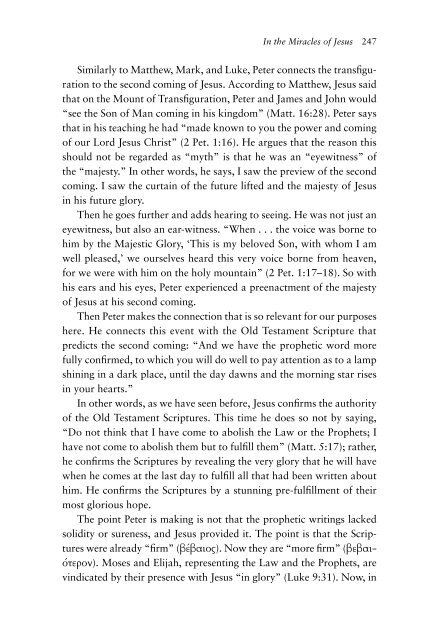Scriptures selfattesting authority question doctrine truthfulness Scriptures
peculiar-glory-en
peculiar-glory-en
You also want an ePaper? Increase the reach of your titles
YUMPU automatically turns print PDFs into web optimized ePapers that Google loves.
In the Miracles of Jesus 247<br />
Similarly to Matthew, Mark, and Luke, Peter connects the transfiguration<br />
to the second coming of Jesus. According to Matthew, Jesus said<br />
that on the Mount of Transfiguration, Peter and James and John would<br />
“see the Son of Man coming in his kingdom” (Matt. 16:28). Peter says<br />
that in his teaching he had “made known to you the power and coming<br />
of our Lord Jesus Christ” (2 Pet. 1:16). He argues that the reason this<br />
should not be regarded as “myth” is that he was an “eyewitness” of<br />
the “majesty.” In other words, he says, I saw the preview of the second<br />
coming. I saw the curtain of the future lifted and the majesty of Jesus<br />
in his future glory.<br />
Then he goes further and adds hearing to seeing. He was not just an<br />
eyewitness, but also an ear-witness. “When . . . the voice was borne to<br />
him by the Majestic Glory, ‘This is my beloved Son, with whom I am<br />
well pleased,’ we ourselves heard this very voice borne from heaven,<br />
for we were with him on the holy mountain” (2 Pet. 1:17–18). So with<br />
his ears and his eyes, Peter experienced a preenactment of the majesty<br />
of Jesus at his second coming.<br />
Then Peter makes the connection that is so relevant for our purposes<br />
here. He connects this event with the Old Testament Scripture that<br />
predicts the second coming: “And we have the prophetic word more<br />
fully confirmed, to which you will do well to pay attention as to a lamp<br />
shining in a dark place, until the day dawns and the morning star rises<br />
in your hearts.”<br />
In other words, as we have seen before, Jesus confirms the <strong>authority</strong><br />
of the Old Testament <strong>Scriptures</strong>. This time he does so not by saying,<br />
“Do not think that I have come to abolish the Law or the Prophets; I<br />
have not come to abolish them but to fulfill them” (Matt. 5:17); rather,<br />
he confirms the <strong>Scriptures</strong> by revealing the very glory that he will have<br />
when he comes at the last day to fulfill all that had been written about<br />
him. He confirms the <strong>Scriptures</strong> by a stunning pre-fulfillment of their<br />
most glorious hope.<br />
The point Peter is making is not that the prophetic writings lacked<br />
solidity or sureness, and Jesus provided it. The point is that the <strong>Scriptures</strong><br />
were already “firm” (βέβαιος). Now they are “more firm” (βεβαιότερον).<br />
Moses and Elijah, representing the Law and the Prophets, are<br />
vindicated by their presence with Jesus “in glory” (Luke 9:31). Now, in


